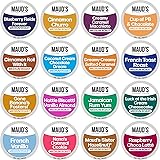Delving into the world of hot chocolate reveals a fascinating tapestry of culinary traditions, each reflecting distinct cultural preferences and gastronomic philosophies. While the video above offers a practical demonstration of crafting two iconic versions, the American and the Italian hot chocolate, a deeper scientific and cultural analysis illuminates the nuances that differentiate these beloved beverages. Understanding the precise ingredient ratios, the rheology of thickening agents, and the impact of cacao mass on organoleptic properties is crucial for any discerning palate or culinary enthusiast aiming to master the art of hot chocolate.
The Rich Heritage of Italian Hot Chocolate: A Culinary Deep Dive into Cioccolata Calda
The Italian rendition of hot chocolate, known as cioccolata calda, stands in stark contrast to its American counterpart, embodying a luxurious and intensely satisfying experience. This beverage is not merely a drink but often approaches the consistency of a thin dessert pudding, demanding consumption with a spoon in many traditional settings. The genesis of this unique textural profile lies primarily in the deliberate inclusion of a thickening agent, most commonly cornstarch, a detail succinctly presented in the accompanying video.
Firstly, the role of cornstarch is pivotal. When suspended in a liquid and subjected to heat, cornstarch granules undergo a process known as gelatinization. The starch molecules absorb water, swell considerably, and eventually rupture, releasing amylose and amylopectin into the solution. This release significantly increases the viscosity of the liquid, transforming a watery milk base into a rich, unctuous emulsion. Achieving optimal thickening necessitates reaching a gentle simmer, typically around 95-100°C (203-212°F), to ensure full activation of the cornstarch. Failing to attain this critical temperature will result in a less viscous, often grainy, beverage where the starch remains unhydrated.
Secondly, the selection and proportion of cacao solids are paramount to the Italian hot chocolate’s distinctive flavor profile. Unlike many American recipes that prioritize a lower cocoa powder ratio, cioccolata calda often features a high concentration of dark chocolate, frequently exceeding 60-70% cacao mass, alongside robust cocoa powder. This elevated cacao content yields a beverage with a profound, complex chocolate flavor, characterized by notes of bitterness, fruitiness, and sometimes earthiness, dependent on the bean origin and processing. The video correctly highlights that the heat from the simmering milk mixture is sufficient to melt the dark chocolate, creating a smooth, homogenous blend when continuously stirred, preventing any cocoa butter separation or “breaking” of the emulsion.
Furthermore, the fat content derived from both the milk and the dark chocolate contributes significantly to the indulgent mouthfeel. Full-fat dairy is almost universally preferred, lending a creamy richness that complements the thickness imparted by the cornstarch. The sugar quantity, as noted, remains variable, allowing for customization to balance the inherent bitterness of the high cacao content. However, traditional Italian preparations tend to lean towards a less saccharine profile than their American counterparts, allowing the pure, unadulterated essence of the chocolate to dominate the sensory experience.
Unpacking the American Hot Chocolate: A Study in Simplicity and Sweetness
In contrast to the dense, dessert-like Italian tradition, American hot chocolate typically embodies a lighter, sweeter, and more fluid consistency, closely resembling a fortified chocolate milk. This differentiation stems from a fundamental divergence in ingredient philosophy and preparation methodology, as visually demonstrated in the comparative video.
Firstly, a defining characteristic of American hot chocolate is the absence of a thickening agent such as cornstarch. This omission directly results in a significantly lower viscosity, rendering the beverage easily drinkable and less akin to a liquid dessert. The textural profile is therefore primarily dictated by the milk’s fat content and the dissolved cocoa solids, offering a smooth, fluid mouthfeel rather than a rich, viscous one. This approach also simplifies the preparation process, eliminating the need for precise temperature control associated with starch activation.
Secondly, the ingredient ratios employed in American hot chocolate often feature a lower proportion of cocoa powder and chocolate relative to milk, a key distinction identified in the video. This reduction in cacao mass contributes to a milder, sweeter flavor profile that is generally less intense and bitter than its Italian counterpart. The emphasis shifts towards a harmonious blend of sweetness and a gentle chocolate note, often enhanced by additional sugar. The chocolate component itself may vary widely, from milk chocolate to semi-sweet, further influencing the overall sweetness and depth of flavor. This adaptability often caters to a broader range of palates, especially those accustomed to sweeter beverages.
Moreover, the speed and ease of preparation are hallmark attributes of the American style. Without the requirement for cornstarch activation or the need to melt a substantial quantity of dark chocolate, the beverage comes together quickly once the milk is heated. This expedited process makes it a convenient option for rapid indulgence, often served in larger mugs and frequently adorned with an abundance of mini marshmallows or whipped cream, augmenting both visual appeal and textural complexity.
Comparative Analysis of Hot Chocolate: Viscosity, Flavor Profile, and Culinary Application
A granular examination of the rheological properties and organoleptic characteristics reveals why American and Italian hot chocolates occupy distinct positions within the global culinary lexicon. While both are comforting chocolate beverages, their design principles cater to differing consumption experiences.
- Viscosity and Mouthfeel: The primary differentiator lies in viscosity. Italian hot chocolate, with its cornstarch inclusion, exhibits a pseudo-plastic flow, meaning its viscosity decreases with increasing shear rate (e.g., stirring or sipping). Its inherent thickness provides a coating sensation on the palate, almost masticatory. Conversely, American hot chocolate maintains a Newtonian fluid property, with viscosity remaining relatively constant, resulting in a lighter, more transient mouthfeel. This fundamental difference dictates the appropriate serving vessel and overall consumption pace.
- Flavor Intensity and Complexity: The higher cacao mass and lower sugar content in Italian hot chocolate deliver a bolder, more complex flavor. This allows for the nuanced notes of the chocolate to shine through, encompassing bitter, fruity, and sometimes earthy undertones depending on the specific cacao origin. American hot chocolate, with its higher milk-to-cocoa ratio and often elevated sugar levels, presents a simpler, sweeter, and milkier profile. The chocolate flavor is present but typically less assertive, designed for broader appeal and quick enjoyment.
- Culinary Application and Cultural Context: Cioccolata calda in Italy often functions as a dessert or an afternoon indulgence, served in smaller cups, emphasizing its richness and providing a satisfying conclusion to a meal or a robust mid-day treat. The American version, conversely, is more frequently consumed as a casual beverage, particularly during colder months, and is synonymous with comfort and quick energy. Its lighter body facilitates larger serving sizes and makes it an ideal canvas for accoutrements like marshmallows and whipped cream.
Understanding these profound differences allows for a more informed approach to preparing and appreciating both styles. Whether one prefers the intense, spoon-worthy decadence of Italian hot chocolate or the comforting, lighter appeal of American hot chocolate, the culinary world offers a spectrum of experiences for every preference. Experimentation with cacao percentages, milk fat content, and even the addition of spices such as cinnamon or chili can further customize these traditional recipes, truly personalizing the hot chocolate experience.







